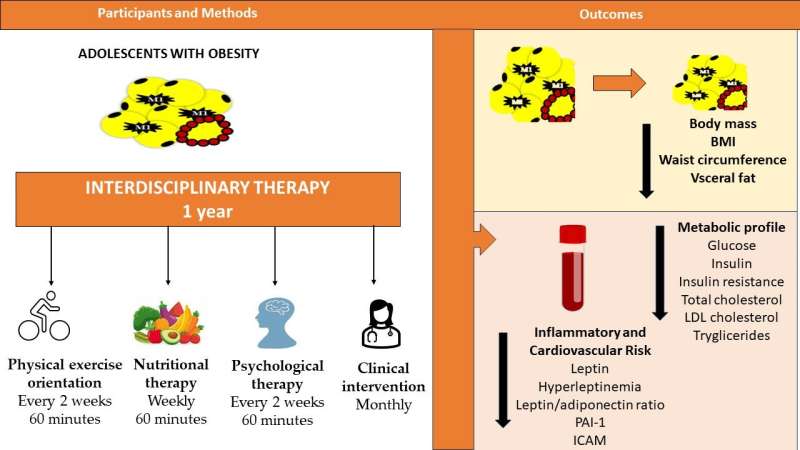This article has been reviewed according to Science X's editorial process and policies. Editors have highlighted the following attributes while ensuring the content's credibility:
fact-checked
trusted source
proofread
Novel treatment strategy reduces inflammation and cardiometabolic risk in adolescents with obesity

After a one-year interdisciplinary therapy program that included clinical, nutritional, psychological and exercise counseling, a group of 22 obese adolescents not only lost weight but also exhibited lower blood levels of inflammatory and cardiovascular risk mediators.
These two achievements led to reduced insulin resistance and hence a lower risk of diabetes, as well as less visceral fat and a better energy balance (the ratio of calorie intake to calorie expenditure). All these factors promoted an overall improvement in health and avoided weight cycling, sometimes called yo-yo dieting.
The study is published in the International Journal of Environmental Research and Public Health.
"We tested a new treatment model that's not as intensive as one whose efficacy our group proved in previous studies. That's important because less intensive means less frequent sessions, so the adolescents don't abandon the treatment and the cost to the SUS [Sistema Único de Saúde, Brazil's national health service] is lower," Ana Raimunda Dâmaso, last author of the article and a professor at the Federal University of São Paulo (UNIFESP) in Brazil, told Agência FAPESP.
The main difference between the intensive model and the semi-intensive model proposed by the article lies in fewer sessions. Previously, the participants went to the university three times a week for exercise training assisted by a professor, whereas in this approach, they were given instructions on how to perform the exercises at home.
As for nutritional counseling, group sessions were fortnightly instead of weekly, and there were no individual sessions or monthly meetings with parents or guardians. In psychological support, the semi-intensive model called for fortnightly group sessions as opposed to weekly group and individual sessions, although individual medical consults were held monthly in both models.
According to Dâmaso, even the less intensive program produced a significant improvement in levels of two hormones secreted by adipose tissue: leptin (a key factor in controlling energy balance and inflammatory processes) and adiponectin (which acts to inhibit inflammation and protect the functions of the pancreas).
"Adolescents with severe obesity typically exhibit hyperleptinemia [overproduction of leptin] and a reduction in adiponectin secretion. This combination intensifies the pro-inflammatory state and cardiometabolic risk," she said.
The semi-intensive intervention proved capable of significantly improving this condition. The prevalence of hyperleptinemia fell from 77.3% of the adolescents to 36.4%. In a previous study by the same group of researchers using the intensive model, the proportion fell much less—from 75.0% to 55.0%. "With regard to hyperleptinemia, therefore, the semi-intensive model actually produced better results," Dâmaso said.
Reducing risk
Obesity has been characterized by specialists as a chronic inflammatory disorder. Onset in adolescence entails even worse lifelong effects because constant inflammation acts in the organism for longer.
In the article, the researchers note that one of the most troubling implications of growing obesity in adolescents is "the association between excessive adipose tissue and the increased risk of developing metabolic and cardiovascular disease during adolescence and adulthood, which increases premature mortality" and substantially decreases the quality of life for the individuals concerned.
"The longer they have severe obesity during their lives, the greater the risk of premature death. Adolescents with extreme obesity exhibit alterations throughout their organism, and we discovered that one of the key ways to deal with this is to put leptin back to work again," Dâmaso said.
"Inflammation and cardiometabolic risk must be reduced throughout the system, lowering hyperleptinemia, cholesterol, blood pressure, insulin resistance, and visceral fat, as well as other biomarkers of inflammation. Controlling obesity in adolescents can also improve sleep apnea and behavioral disorders such as anxiety, depression, and bulimia, as we've found in previous research."
Earlier studies by the group showed that high levels of leptin in obesity are associated with an increased risk of cardiovascular disease, eating disorders, inflammation, and alterations in neuroendocrine energy balance regulation resulting in impairment to weight loss efforts.
"Among the adolescents that took part in the study, 77.3% displayed hyperlipidemia (abnormally high blood fat levels) and therefore already had metabolic and pro-inflammatory alterations in progress. We were able to reverse these and bring the energy balance back to normal," said Deborah Cristina Landi Masquio, first author of the article and a researcher who belongs to UNIFESP's Obesity Study Group. The study was part of her Ph.D. thesis.
"A balance between levels of leptin and adiponectin reduces the inflammation characteristic of obesity and the risk of various obesity-related diseases. All this is linked to a reduction in insulin resistance. At the start of the study, 81.8% of the participants had insulin resistance. By the end, the proportion had fallen to 50%," Masquio said.
The results also showed a reduction in two important biomarkers of cardiovascular risk, PAI-1 and ICAM. PAI-1 is considered a major inhibitor of the fibrinolytic (blood clotting regulation) system, and elevated levels of this protein can lead to a pro-thrombotic state that may contribute to the development of cardiovascular disease.
ICAM-1 is a cell surface glycoprotein associated with atherosclerosis (hardening of the arteries). "In adolescents with diabetes, levels of PAI-1 correlate with increased glycemia, triglycerides and total cholesterol, and carotid artery thickening," Dâmaso said.
The interdisciplinary intervention led to a reduction in waist circumference and visceral fat. "This is an important outcome. Abdominal fat correlates closely with comorbidities of obesity such as metabolic alterations and inflammation," Dâmaso said.
More information: Deborah Cristina Landi Masquio et al, Interdisciplinary Therapy Improves the Mediators of Inflammation and Cardiovascular Risk in Adolescents with Obesity, International Journal of Environmental Research and Public Health (2023). DOI: 10.3390/ijerph20237114



















